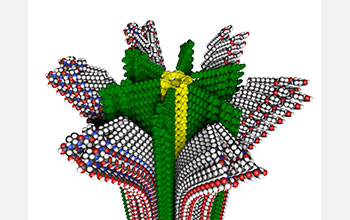Multimedia Gallery
Researchers develop completely new polymer
Northwestern University researchers have developed a new hybrid polymer with removable supramolecular compartments, shown in this molecular model.
More about this image
Researchers at Northwestern University have developed a completely new hybrid polymer that might one day be used in artificial muscles or other lifelike materials; for delivery of drugs, biomolecules or other chemicals; in materials with self-repair capability; and for replaceable energy sources.
"We have created a surprising new polymer with nano-sized compartments that can be removed and chemically regenerated multiple times," said Samuel I. Stupp, a materials scientist at Northwestern and senior author of the study.
He adds, "Some of the nanoscale compartments contain rigid conventional polymers, but others contain the so-called supramolecular polymers, which can respond rapidly to stimuli, be delivered to the environment and then be easily regenerated again in the same locations. The supramolecular soft compartments could be animated to generate polymers with the functions we see in living things."
The hybrid polymer combines the two types of known polymers: those formed with strong covalent bonds and those formed with weak, non-covalent bonds, well known as "supramolecular polymers." The integrated polymer offers two distinct compartments with which chemists and materials scientists can work to provide useful features.
The research was supported by the National Science Foundation (NSF) (grant DMR 15-08731).
To learn more, see NSF News From the Field story Researchers develop completely new kind of polymer. (Date image taken: January 2016; date originally posted to NSF Multimedia Gallery: April 13, 2016)
Credit: Mark E. Seniw, Northwestern University
Images and other media in the National Science Foundation Multimedia Gallery are available for use in print and electronic material by NSF employees, members of the media, university staff, teachers and the general public. All media in the gallery are intended for personal, educational and nonprofit/non-commercial use only.
Images credited to the National Science Foundation, a federal agency, are in the public domain. The images were created by employees of the United States Government as part of their official duties or prepared by contractors as "works for hire" for NSF. You may freely use NSF-credited images and, at your discretion, credit NSF with a "Courtesy: National Science Foundation" notation.
Additional information about general usage can be found in Conditions.
Also Available:
Download the high-resolution JPG version of the image. (583.0 KB)
Use your mouse to right-click (Mac users may need to Ctrl-click) the link above and choose the option that will save the file or target to your computer.



